Reviewing the Concept of Transformational Ministries
 A review of the book
A review of the book
Transformational Regional Bodies,
by Roy M. Oswald and Claire S. Burkat
This review, written by Judith Gotwald, is offered from the viewpoint of one congregation experiencing its leadership philosophies.
In 2001, Bishop Claire Burkat of the Southeastern Pennsylvania Synod co-authored a book with Roy Oswald of the Alban Institute. The book, entitled Transformational Regional Bodies: Promote Congregational Health, Vitality and Growth, is a puzzling book, filled with typos, conflicting premises that go unnoticed by the authors, and a few good ideas. It gives the illusion of being scholarly but in fact builds on hypotheticals and limited firsthand parish leadership experience.
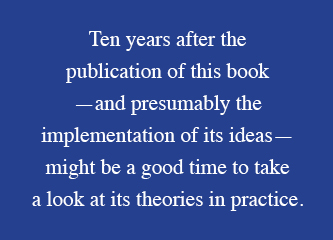 Why review this book ten years after publication? The co-author, Claire Burkat, was elected to lead a judicatory in 2006, five years after this book’s publication. The advice she gives in this book has been put to the test under her leadership with results the book does not foresee. While the book uses many “success” illustrations, there are notable failures which go unrecorded.
Why review this book ten years after publication? The co-author, Claire Burkat, was elected to lead a judicatory in 2006, five years after this book’s publication. The advice she gives in this book has been put to the test under her leadership with results the book does not foresee. While the book uses many “success” illustrations, there are notable failures which go unrecorded.
The opening pages contain a detailed analysis of two opposing judicatories it says are in the American Northwest. Pages of statistics of one’s failure and the other’s successes are impressive, . . . but both examples are entirely hypothetical – statistics and all!
The book is written for middle management in the church. From the beginning the authors recognize that some denominations have no such thing as middle management and the book assumes middle management has powers its judicatories may not allow. The book spends no time discussing the judicatory’s relationship with any controlling influences, whether they be constitutional or structural. In this book, middle management IS the highest authority.
For example, the Lutheran Church (ELCA), by its own definition, is comprised of “interdependent” organizations. There is to be equality and respect among Lutheran congregants, congregations and leadership at every level. Constitutions mention congregational consent frequently. Although this is still the premise of Lutheranism, this book is a blueprint for ignoring its traditions and historical structure. Currently and perhaps following the advice of this book, middle judicatory is running roughshod over member churches, forcing closure against congregational wishes and seizing property and assets — all in the name of “transformation.”
The foundation of the book appears to accept a church view that is sharply divided into unnecessary factions — clergy vs laity. Much of the focus is on congregational relations with clergy, making it seem that congregations exist to support clergy, first and foremost. Most congregations think pastors serve congregations. The premise is in conflict with reality from the start.
The management of church relations as described by this book assumes a congregation’s dependency upon clergy that is not healthy. The book teaches casting the weak and troubled to the side for the sake of judicatory health and staff/time/resource management.
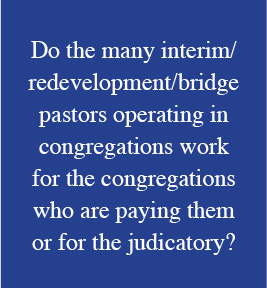 “You do not have the luxury of giving everyone who asks for help whatever time you have available. Some tough decisions need to be made as to where your Regional Body is going to invest time, energy, and resources. Thinking in terms of TRIAGE is a most responsible thing to do at the present time. Congregations that will die within the next ten years should receive the least amount of time and attention. They should receive time that assists them to die with celebration and dignity. Offer these congregations a ‘caretaker’ pastor who would give them quality palliative care until they decide to close their doors. It is the kind of tough-minded leadership that will be needed at the helm if your organization is to become a Transformational Regional Body.”
“You do not have the luxury of giving everyone who asks for help whatever time you have available. Some tough decisions need to be made as to where your Regional Body is going to invest time, energy, and resources. Thinking in terms of TRIAGE is a most responsible thing to do at the present time. Congregations that will die within the next ten years should receive the least amount of time and attention. They should receive time that assists them to die with celebration and dignity. Offer these congregations a ‘caretaker’ pastor who would give them quality palliative care until they decide to close their doors. It is the kind of tough-minded leadership that will be needed at the helm if your organization is to become a Transformational Regional Body.”
Turn your back on people asking for help is their advice for church leadership. Should this philosophy spread from the church to all struggling people in the world, the advice would be catastrophic. Expect the same within the church. This outlook is devoid of Christianity and the biblical imperatives to love one another. Should the Regional Bodies share this philosophy with the hundreds of small churches who vote for them and send them support offerings, they would surely be sent packing. Do the congregations targeted for death know that the pastor they are paying is there only to help them die? If not, the judicatory is behaving in a deceitful manner. The atmosphere created in a judicatory that practices this philosophy is bound to be fraught with distrust. The purpose of a Regional Body is not to make their jobs easier. Congregations must be confident that they can turn to their Regional Bodies for help. It is a key reason for them to be in relationship with any Regional Body.
The authors spend a great deal of time sympathizing with over-burdened clergy. A long list of statistics details burdens borne by clergy, including long hours, stress on family, burnout, etc.
There is no corresponding list or study cited on the burdens of the laity who work, uncompensated, under the same conditions and with no support system in the church. There are only passing references to the harm clergy can cause in a congregation. There is little recognition that whatever damages might occur will remain problematic for the laity for years, long after clergy pack up their problems and move to greener pastures.
The language of the book reveals something akin to distain for church members. For example, in discussing the training of clergy, the authors write:
“We as a church . . . will send men and women into battle against the principalities and powers of darkness within any congregation and expect that none of them to get wounded, seriously demoralized, stressed beyond their capacity to cope, experience family breakup, tempted beyond their capacity to resist, or be rendered mentally and emotionally unstable.”
If this medieval view weren’t bad enough, the authors think things are going to get worse – and it is going to be the fault of the laity. They write:
“It is our prediction that we are going to encounter more and more congregational conflict the further we move into the 21st century. It is clear that the stress levels of individuals within our culture are steadily rising with more and more pressure being placed on people within the corporate world. These people are going to bring their stress to their church and create more stress for their clergy.
All ye who are heavy laden — go elsewhere?
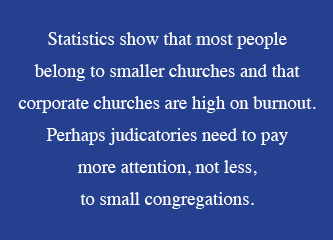 The authors judge congregations by size, the smallest being the “family church” and “pastoral church.” Most congregations fit into one of these two categories, but it is clear that the authors see these categories as undesirable and that small churches exist to become bigger and better. All that stands between them and becoming a wealthier “program church” or “corporate church” is the laity which, in their view, have a bad habit of focusing on their own spiritual needs.
The authors judge congregations by size, the smallest being the “family church” and “pastoral church.” Most congregations fit into one of these two categories, but it is clear that the authors see these categories as undesirable and that small churches exist to become bigger and better. All that stands between them and becoming a wealthier “program church” or “corporate church” is the laity which, in their view, have a bad habit of focusing on their own spiritual needs.
They describe family churches as being controlled by a matriarch or patriarch and discuss ways pastors can be prepared to thwart their power. A healthier Christian way of looking at a family church with strong lay leadership might be to teach pastors to work with the skills innate in any church which has survived for decades with minimal help from clergy. Without strong lay leaders they would be lost — but perhaps that’s part of the transformational plan. Control! Oswald and Burkat spend no time discussing empowering the congregation. Their primary view is centered on the role of pastors and forcing congregations to feed into leadership from above.
At one point the authors recommend, “that Regional Bodies employ tough-minded, intentional Interim Pastors to intervene in their most important congregations.” (We can only assume that the “important” congregations are the bigger and richer congregations.) A translation might be “These congregations need a no-nonsense pastor to tell them what to do.” This seems to be at odds with the very process they describe for visioning and working with congregations and which they admit requires the consent of the people.
There are more troubling dichotomies in the book. The authors explain that as the book was nearing completion, the founder and president emeritus of Alban Institute, Loren Mead, produced a report they felt compelled to include in draft form as an appendix. It is so important, they state in the early pages of the book, that it should be read first.
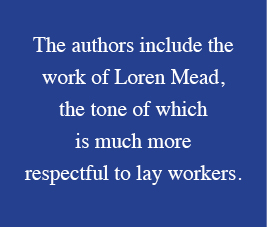 It is, indeed, an interesting report and perhaps the best part of the book. Unlike the rest of the book, the laity is treated with respect. Loren Mead writes:
It is, indeed, an interesting report and perhaps the best part of the book. Unlike the rest of the book, the laity is treated with respect. Loren Mead writes:
“Every congregation has a handful (hopefully more) of lay people who are opinion-leaders in the community as well as the church. When these lay people have had good opportunities to know and participate in important work of the judicatory, they will move the climate of the congregation toward the judicatory. Note that I say ‘important work,’ not ‘busy work’ or powerless and endless task forces. Judicatory executives need to be recruiting such leaders, listening to them and engaging with them. Efforts to that end will bring life to the relationship between congregation and judicatory, and will be an asset when there is a change of pastorate or some other congregational crisis.”
While it’s unclear why a change of pastorate is classified as a crisis, Mead’s thoughts are well-formed.
Mead also comments on the use of consultants in evaluating congregations in transition. He stresses that consultants are hired and paid by the congregation and should be responsible to the congregation. He writes:
“Judicatories often want consultants to operate as staff, carrying out the intentions of the judicatory. Such an understanding assumes that the judicatory controls what will happen. This may be in the best interests of the judicatory, but it violates the integrity of the congregation. In the long run, I think this is very bad for the connection between congregations and judicatories. It is dishonest.”
Mead’s advice is commonly ignored in SEPA Synod under Claire Burkat’s leadership and that of her predecessor. SEPA Synod uses consultants, requiring the congregations to pay for their services while the consultants report to SEPA. This book devotes a good portion to Physes, a consulting firm used in just this way by SEPA. This section of the book reads like an advertisement. The book extols Physes as an organization of great integrity, yet this “dishonest” methodology was used with SEPA, Physes and at least one member congregation, Redeemer, in the late 1990s, just prior to the publication of this book.
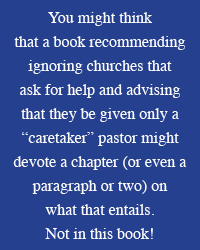 Just as Mead predicted, it damaged relations between Redeemer and the judicatory. It was not the only such incident. The SEPA relationship with consultants seems to be so entrenched that when Redeemer congregation independently hired a consultant to lead a workshop (which went very well) the congregation felt betrayed to learn that the consultant filed a report with SEPA without the congregation’s knowledge or permission.
Just as Mead predicted, it damaged relations between Redeemer and the judicatory. It was not the only such incident. The SEPA relationship with consultants seems to be so entrenched that when Redeemer congregation independently hired a consultant to lead a workshop (which went very well) the congregation felt betrayed to learn that the consultant filed a report with SEPA without the congregation’s knowledge or permission.
Responsibility is just as murky with other SEPA-fostered relationships. Do the many interim/redevelopment/bridge pastors operating in congregations work for the congregations who are paying them or for SEPA? Discussions with both clergy and lay members reveal that these relationships are often strained because this is unclear.
Claire Burkat, in her role as bishop of the Southeastern Pennsylvania Synod, has ignored Mead’s excellent advice and much of her own. From her earliest days in office, she found ways to bypass local leadership and constitutional provisions to achieve Synodical goals. Her policies have encouraged church closings at an alarming rate and created long-term contention that has been damaging to Christian community and eroded trust for the judicatory. Her approach, devoid of love, has sparked numerous law suits which may outlast her tenure. Studies should be done on the real effects of this approach to ministry, but it is hard to interview churches experiencing modern excommunication.
Transforming Regional Bodies should be widely read in SEPA Synod, where statistics are, with few exceptions, following a downward trend. (Redeemer, forced into closure by the co-author of this book, was one of the few growing churches. Unbeknown to us, we had been placed on the ten-year death track. During that time, unbeknown to synod, we grew fivefold — but too late to change Synod’s tunnel-visioned view.)
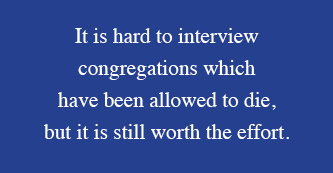 Regional Bodies must rediscover that they exist to serve in a Christlike fashion. A study of this book’s ideas as compared to practice might reveal that it is the Regional Bodies that need transforming.
Regional Bodies must rediscover that they exist to serve in a Christlike fashion. A study of this book’s ideas as compared to practice might reveal that it is the Regional Bodies that need transforming.

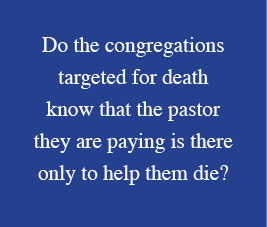
With the caveat that I haven’t read the book, I am left with the question “Where is Jesus?” in the author’s suppositions. Isn’t He the head of the church and doesn’t His opinion count above all others?